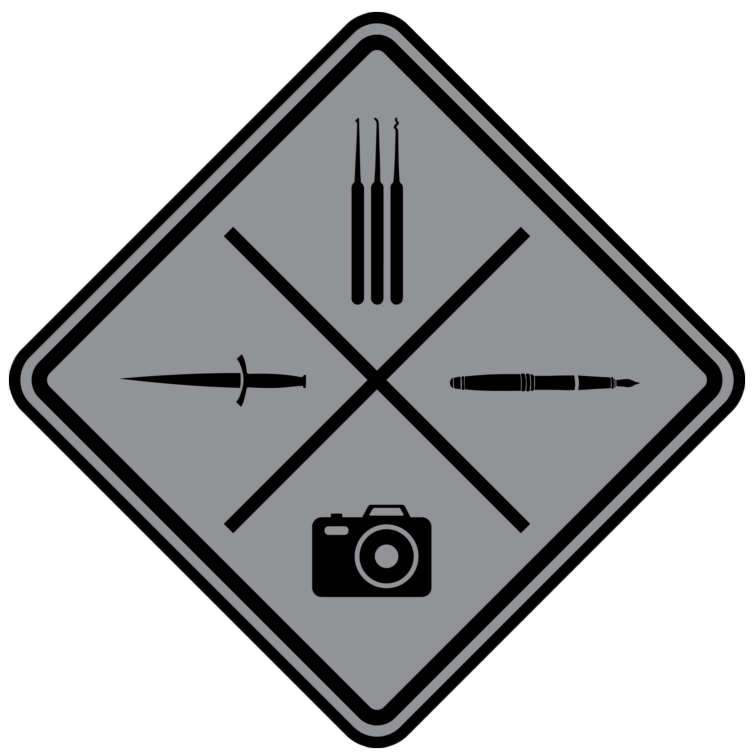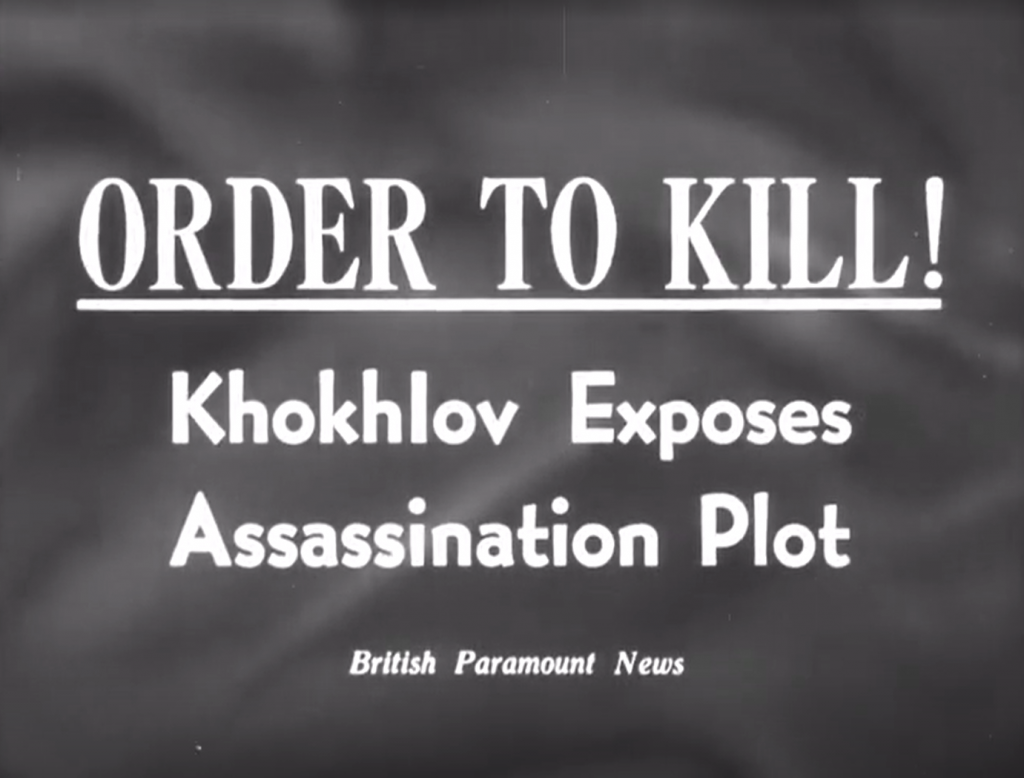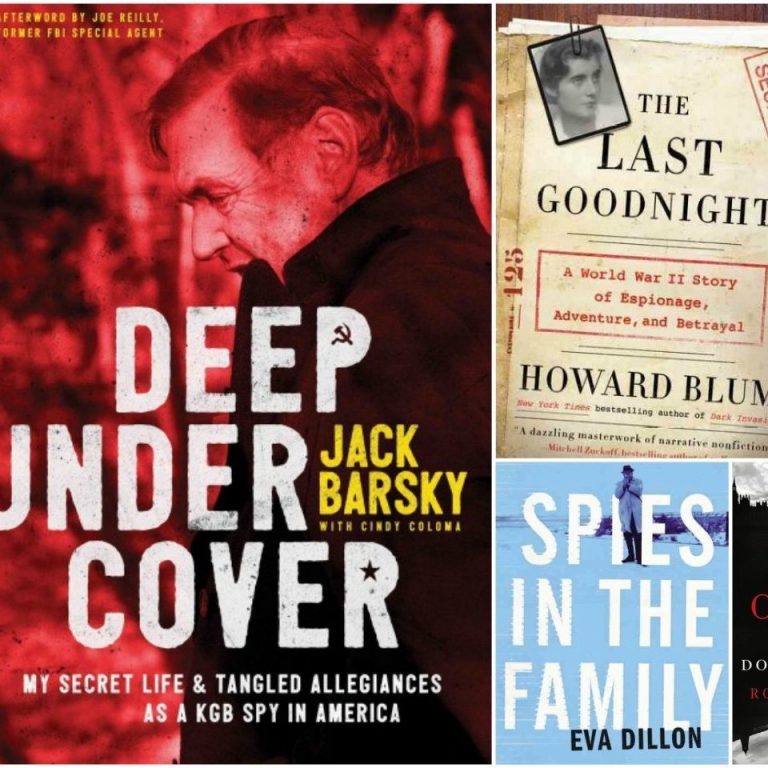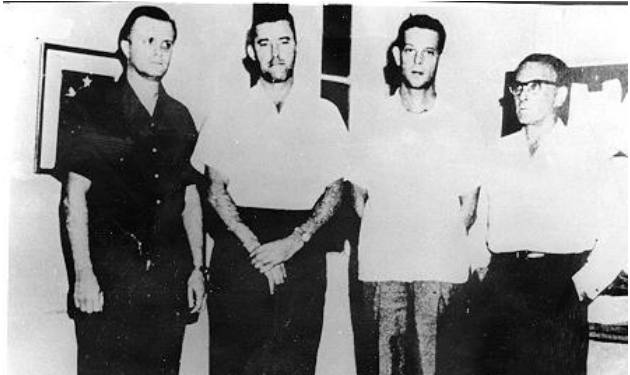Introduction
Nikolai Evgenievich Khokhlov was a Soviet war hero and capable MVD agent when he was selected for a dangerous mission outside of the USSR: find and kill a Russian dissident in Frankfurt, West Germany named Gregory Okolovich. Khokhlov went to Frankfurt as ordered, but his actions there shocked his superiors in Moscow, and opened a new chapter in the Cold War.
In the Name of the Soviet Union
Khokhlov had proven his worth at a young age, both before and during World War II. Prior to the German invasion he had been a member of the Young Communist League, and had aspirations to become an actor, with a few small roles in several Soviet films. When hostilities began, he was initially rejected for military service due to his poor eyesight; however, as the situation became more desperate for the Soviet Union once Germany invaded, Khokhlov was recruited as an NKVD asset. An older member of the vaudeville union where Khokhlov was working spotted and assessed him as having the potential for intelligence work and recommended him for recruitment. The 19-year-old Khokhlov was already assigned to a paramilitary Demolitions Battalion within Moscow but was released to the NKVD from that assignment.
At this time, the Soviet government was sacrificing millions of bodies in an effort to overwhelm the Germans, and Khokhlov had no desire to be one of them. His own father and stepfather had already died in the war. His father served as a battalion commander in the Soviet army until he had made an errant comment to one of his soldiers that Stalin was as responsible as Hitler for the Soviet Union’s recent losses. This was enough to get him reassigned to a penal battalion given the most dangerous missions of all; he was quickly killed in fighting. Likewise, Khokhlov’s stepfather had taken up arms against the invading Germans, but as a lawyer with no real martial capabilities, he too died almost immediately.
Once Moscow was under siege by German forces, Khokhlov was selected for a near-suicide mission against high-ranking German officers during the Battle for Moscow. With the city primed to fall before the invading German army, a last-ditch effort was mounted to target and kill officers while their guard was down. Khokhlov and three other NKVD agents operated undercover as a vaudeville quartet that would entertain the Germans as they celebrated their successful occupation of the enemy capital. Khokhlov himself was an accomplished whistler, which had gotten him accepted into the vaudeville union in the first place, and this talent would be his cover for action. Once the German officers were gathered in an audience for the vaudeville show, the performers would instead attack and kill as many as possible.
The team made Khokhlov’s deceased stepfather’s apartment their base of operations. While awaiting the arrival of the German Army in Moscow, they received training in explosives and small arms until they were reasonably proficient. Afterwards they moved on to training in tradecraft and even international etiquette; the customs and mannerisms they would need if interacting with high-ranking German officers at a formal celebratory dinner.
Fortunately for Khokhlov, the operation was canceled when the German army failed to fully take Moscow by the end of 1941. The young Khokhlov breathed a sigh of relief as he had been certain the plan would have ended with all four agents quickly killed. But his role thus far had brought him to the attention of none other than Pavel Sudoplatov, the NKVD’s chief of wet work. Sudoplatov came to Khokhlov’s apartment on New Year’s Day, 1942, and disbanded the quartet while offering Khokhlov an opportunity to further serve Russia, this time in Germany itself. Khokhlov eagerly accepted, and afterwards was known by the code name Whistler in future operations with the NKVD and MVD.
Khokhlov’s first task was to travel to Ankara, Turkey and take on the identity of a real German citizen with whom he bore a near-identical likeness. From there he would travel on the other man’s documents into Berlin. However, Khokhlov fell ill with typhus just before the mission was to begin, and it was canceled. Although Khokhlov wasn’t briefed on his mission before arriving, documents late reveal the NKVD had designated him to assassinate Franz Von Papen in Turkey. Von Papen served as Adolf Hitler’s Vice-Chancellor from 1932-1934 and was the German Ambassador to Turkey through 1944.
Later in 1943, Khokhlov was sent to a POW camp for German officers inside of Russia. There he and another agent codenamed “Karl” spent 30 days posing as captured Germans, to perfect the mannerisms of Germans and validate his command of the language. The POW camp was a perfect testing ground as his discovery there by other POWs would happen under circumstances controlled by the NKVD. Although he had a few close calls in the prison camp, such as accidentally speaking Russian upon waking up early one morning, Khokhlov and Karl remained undiscovered by their fellow POWs. In fact, he was so successful at blending in that a separate Soviet counterintelligence team attempted to recruit him during interviews at the camp. These agents were not briefed on Khokhlov’s mission and had no idea of his true identity.
With this final hurdle passed, Khokhlov and Karl flew into Belarus in the dead of night, wearing the uniforms of a German First Lieutenant and Corporal. Their mission was the assassination of Reichskommissar Wilhelm Kube, the senior German leader for occupied Belarus. Linking up with partisans on the ground, they were able to make their way from the landing field to a nearby town where they hitched rides in German troop trucks to Minsk to carry out their mission. Once on the ground in Minsk, Khokhlov looked for ways to carry out the mission but found that Kube had excellent protective measures in place. A public killing would be extremely difficult to carry out, as would infiltrating the house where Kube resided. In the end, Khokhlov made contact with Yelena Mazanik, Kube’s housekeeper. She had remained neutral in the conflict thus far but armed with the knowledge of her husband’s past collaboration with the NKVD, Khokhlov was able to coopt her for the mission. On September 22nd, Mazanik, was able to plant a time bomb under Kube’s bed, which detonated at 1:20am while he slept, killing him instantly. Khokhlov and Mazanik both successfully escaped in the aftermath of the assassination, but the Nazis killed more than 1,000 locals as retaliation for Kube’s death.
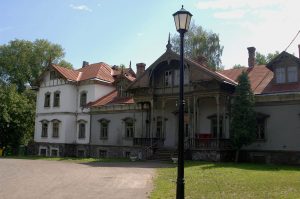
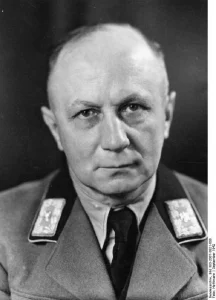
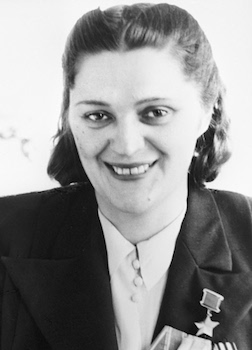
For the next year, Khokhlov fought side by side with the partisans in Belarus, slowly pushing out the occupying German Army. Moving towards Western Europe, Khokhlov marveled at the far better standard of living in areas outside of the Soviet Union. Here he first began to wonder if communism and the Soviet system were truly best for the people. The seeds of doubt had been planted.
In the Name of the People
Near the end of World War II, Khokhlov was sent next to Romania, where he lived as a sleeper agent under the alias of Stanislaw Levandowski, a Polish immigrant who ran a small electronics shop. While there he did not take part in any significant intelligence operations, just worked to fully immerse himself into the local community until such a time as he was needed. Khokhlov parroted pro-democracy talking points to build the trust of the locals over the next several years, but gradually found himself becoming increasingly convinced as to their validity. He felt more and more separated from the Party and communist ideology in general.
In 1949 he sent a letter back to General Sudoplatov at the MVD, requesting to return to Moscow and be released from his intelligence career after eight years. He returned to Moscow and initially was allowed to attend a university program while continuing to work for the MVD. But even this was eventually taken away from him and his request to resign was denied. Instead, he was ordered on another liquidation mission, this time to Paris. A Russian émigré there named Alexander Kerensky was speaking out against the Soviet Union and had thereby earned the ire of the MVD. Khokhlov was to be issued a pair of Parker fountain pens converted into single shot pistols; one for the émigré, and one for his friend who had reported on him to the Soviet government. Khokhlov would take care of the problem and the witness on the same trip.
Khokhlov refused the mission.
General Sudoplatov was shocked, and even drove directly to Khokhlov’s apartment to discuss it with him personally. In the end he decided to assign the mission to another operative. Khokhlov lived for months in apprehension that he would be arrested or even executed. Eventually the tension passed although he was well aware that to refuse any further assignments would put him in mortal danger. His survival and continued work with the MVD probably came down to his indispensable skill set and experience. Despite his suspicious refusal to carry out his orders, Khokhlov was one of only 13 agents under Sudoplatov’s command who had the training and experience to operate in foreign countries as illegal agents. In fact, his wartime exploits were so highly regarded that the 1947 Soviet film “Secret Agent” is a fictionalized version of Khokhlov’s work during the war. It was the highest grossing film in the Soviet Union that year, and one of the first of a series of films in the burgeoning Soviet espionage drama genre.
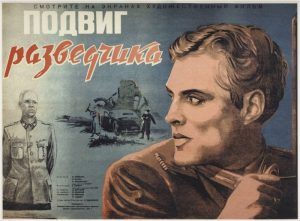
Unbeknownst to Khokhlov for many years was what had occurred in the immediate aftermath of his refusal to assassinate Kerensky. Stalin himself had ordered the hit, and General Sudoplatov took an almost unbelievable risk when he reported to Stalin that the assassination could not be carried out; he claimed that there was a problem with Khokhlov’s fake Austrian passport which prevented him from traveling to Paris for the mission. Had Sudoplatov reported the truth, Khokhlov would almost certainly have been killed for this breach of trust with the MVD.
Khokhlov’s next assignment took him to the Soviet sector of Berlin in 1952. There he worked at Field Post Number 62076, the cover organization for the MVD’s headquarters in Germany. His work there was primarily administrative in nature, but it put him into contact with two reliable subagents on the Soviet payroll. Kurt Weber, aka “Franz” was a devout German communist who had fought in Spain and France against the German Army. He’d been recruited by the Soviets in France but was now working as a lowly police clerk near Berlin, a man adrift in post-war Europe.
In France, agent Franz had worked with another man, Hans Kukovich, aka “Felix”. The men made an excellent team, and Franz had even rescued Felix after he was captured by the Nazis and sentenced to death. Franz bribed a German prison guard to have Felix transferred to a hospital for an examination. Then Franz appeared at the hospital in a German Army uniform with forged papers to transport Felix elsewhere for interrogation. The two escaped and rejoined the fight against the Nazis. As of 1952 both men were on the MVD payroll but being held in “special reserve” for when they were needed for a key mission. That mission soon appeared, with Khokhlov at the helm.
Operation Rhine
By October 1953, the Soviets were working furiously to spread influence (and intimidation) throughout the rest of Europe. Defectors and vocal dissidents outside the borders of the Soviet Union were always at the top of their lists for liquidation. Khokhlov, now 31 years old was ordered to prepare for a critical mission across the border in West Germany. He would supervise agents Franz and Felix in the liquidation of a high-profile target. His new mission was the hunt for Georgiy Okolovich. Okolovich was the chairman of a group of anti-communist Russian emigres based in Europe known as the National Alliance of Russian Solidarists. This alliance was ramping up its efforts to subvert Soviet rule with increasingly drastic methods. They were known to have smuggled anti-Soviet pamphlets across the border using balloons and operated a program of subversion by approaching Soviet sailors in foreign ports who were on temporary shore leave. They also published a newspaper called Possev (“The Sowing”) filled with anti-Soviet articles.
A team of three German MVD agents had already attempted to kidnap Okolovich in 1951. But the mission failed when they could not locate him in West Germany, and two of the team members subsequently defected now that they were outside of the Eastern Bloc. Most crucially, after the failed kidnapping, the 10-year-old daughter of one of the defectors disappeared from Moscow. Khokhlov believed that the girl had been smuggled out of the country by the Solidarists in order to be reunited with her father. Another senior leader named Dr. Alexander Trushnovich based in West Berlin was successfully located and forcibly kidnapped from his apartment by a different team just two weeks before Khokhlov’s mission went forward. Trushnovich’s kidnappers accidentally killed him when he suffocated on a rag stuffed into his mouth, a fact that was not revealed by the Russian government until 1992.
The German agents were activated and traveled to Moscow, spending months in training for the mission, including jiujitsu, marksmanship, evasive driving, surveillance, and countersurveillance. Khokhlov himself focused on the planning and logistics of the operation, much as he had ten years previously for the assassination of Kube. He traveled to West Germany and brought back a number of small items to use as possible concealment for unique weapons, including cigarette cases, handbags, and wallets. He visited Laboratory Number 12, as the Chamber was called at that time, to personally oversee the fabrication of the unique, silent weapons being developed for this mission. He also arranged for false Austrian passports for the mission participants, as the MVD had an agent inside the Austrian passport office in Vienna at that time. After the weapons were delivered, the team practiced with them until a fatal first shot was all but guaranteed. Live-fire tests against wooden barriers, and even a leg of lamb, proved the weapons possessed both the kinetic energy and the silent ignition that was necessary for a deniable assassination. They also did full-scale rehearsals of a variety of scenarios, including shooting Okolovich from the window of a moving vehicle, or staging a car accident with him, and then shooting him as they went to “check on” the driver of the other car.
With the team and weapons poised in Austria for the go-ahead, Khokhlov once again traveled to Frankfurt on his own, in the first phase of Operation Rhine. Unbeknownst to anyone else, Khokhlov had prepared an encoded paper record containing many details of his work with the MVD and the personnel there, leaving it in a safe deposit box in Switzerland before traveling on to Austria and West Germany.
In the Name of Conscience
Once in West Germany, Khokhlov diverted from his assigned mission in the most stunning way imaginable. Rather than facilitate the assassination, Khokhlov instead approached Okolovich at his apartment one night. When Okolovich opened the door, Khokhlov greeted him first in German, then switched to Russian, saying, “Georgiy Sergeyevich, I have come to you from Moscow. The Central Committee of the Communist Party of the Soviet Union has ordered your assassination. The murder is entrusted to my group… I can’t let this murder happen.” A long and startling conversation ensued, but Okolovich believed him almost from the start.
Khokhlov was greatly saddened to realize that the National Alliance of Russian Solidarists did not possess the means to spirit his family out of the Soviet Union, now that he was willing to defect. He would need to find another way to get the Soviet government to release his family.
Okolovich facilitated an introduction to the US government on February 19th, 1954. Khokhlov presented himself as a defector seeking political asylum. Over the course of several tense meetings at Okolovich’s apartment and elsewhere, the US agents gradually began to believe the story Khokhlov was telling. He reported that a courier had smuggled weapons for the team to Augsburg, Germany, from where Franz and Felix brought them to Frankfurt and hid them inside a car battery in the baggage room at the railway station. The pistols were in sealed plastic boxes inside the container filled with sulphuric acid, as a virtual guarantee that no unsuspecting person would stumble upon them. A few days later at a scheduled meeting with Franz and Felix, the pair were detained by the US agents and brought in for interrogation. Khokhlov arranged for both of them to be offered asylum and no criminal charges if they cooperated fully with the counterintelligence personnel. Both immediately agreed and defected as well.
The Press Conference
For the next three months Khokhlov was debriefed first at Camp King just outside of Frankfurt, and later at a remote hunting lodge by counterintelligence agents. They eventually compiled a dossier based on his interviews approximately four feet thick. He was also escorted to Switzerland where he retrieved the encoded papers he had left there in a safe deposit box and turned over to the Americans.
Once the agents had determined the veracity of his claims, a decision was made to use Khokhlov against the Soviet Union in the most public way possible. It was the best chance they had to reveal to the world the cold-bloodedness of the Soviet intelligence apparatus, as well as prevent any consequence to his family still residing in Moscow. In May 1954, Khokhlov was the star of a shocking press conference in which he presented his story to a room packed with more than 200 reporters. The tools provided to him by the Chamber were on full display. Most famously, Khokhlov had been issued four firearms quite unlike anything else the world had ever seen.
Two of the four pistols were equipped with three single-shot .25 caliber barrels loaded with hollow point bullets filled with potassium cyanide. These poisoned rounds held a mixture of two-thirds potassium cyanide and one-third gum binder, to seal it in the hollow point of the bullet. Each round contained approximately half a gram of poison, more than 100 times a lethal dose. The rounds were locked together in a unique triple-pack that was loaded into the breach of the pistols from the top. The barrel length was negligible, so the shooter had to be very close to the target to fire. Death was virtually assured if you were struck by one of these rounds.
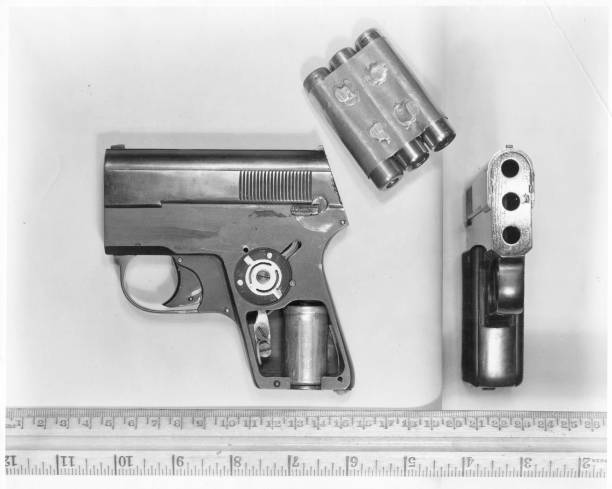
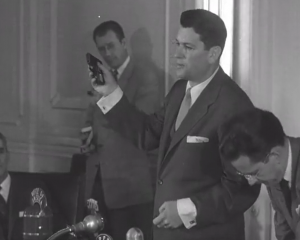
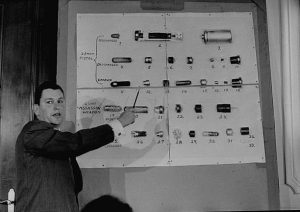
Perhaps more shockingly for 1954, the pistols used both an electronic ignition system powered by flashlight batteries and captive-piston ammunition; possibly the first experiment into this highly successful realm. When fired, these cartridges are nearly silent because all of the expanding gasses are captured behind a piston, which drives the bullet forward while simultaneously sealing the cartridge shut. According to Khokhlov, the sound of firing was no louder than a finger snap virtually undetectable in most environments and situations.
The other two firearms were disguised as cigarette cases, intended for a close-range attack. Khokhlov described them as “weapon blocks” which is more accurate than pistols, as they in no way resembled conventional handguns. With the case lid open, real tobacco-filled cigarette tips were visible inside, concealing the weapon’s barrel and an expansion chamber that functioned as a sound suppressor. The case lid itself functioned as a safety to prevent an accidental or negligent discharge until the target was present. One cigarette case held two barrels, and the other four barrels. The trigger mechanism was a button on top of the case, exactly where the thumb naturally rested when holding a cigarette pack. The leather covering for the cigarette case had been shaved down on the underside to allow the assassin’s thumb to easily find the button, while hiding it from view. With no sighting mechanism, the assassin had to be right in front of the intended target. A cigarette case was the perfect tool as the assassin could approach the target with the case held out in front of him, as if to offer a cigarette. A gesture like this would be dismissed as harmless by both the target and any witnesses present.
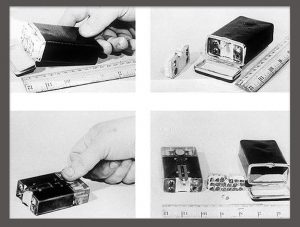
This is the only documented deployment of these particular weapons, and only because the assassin willingly presented them to the world. Although Khokhlov describes these weapons as designed and fabricated specifically for this mission, one is left to wonder just how many times weapons like these were used by the Soviets to liquidate a target without the world ever knowing.
Besides the fiendishly clever weapons developed and provided by the Chamber, Khokhlov told a story that deliberately tugged on the heartstrings. He held up photos of his wife and children back in Moscow, and worried as to what would become of them now that his defection was public. He described his wife Yanina as his moral center, and the person who had convinced him that it was wrong to go through with the murder of Okolovich, no matter the consequences.
The discussion of his wife and child were in actuality part of a complex plan to smuggle them out of the country. Khokhlov’s US handlers had worked out a scheme to have US embassy personnel in Moscow arrive at his apartment just moments after the broadcast began, along with members of the international press. They would entreat Yanina to bring the baby to the US embassy to hear her husband’s broadcast, which was repeating every hour. This would be the pretext to get her out of the clutches of a vengeful Soviet government. But in the end, for reasons that are still unclear to this day, no one from the embassy actually went to her apartment as planned. Khokhlov felt betrayed, and Yana and the baby were sent to a labor camp for more than a year after his defection, and never allowed to emigrate from the Soviet Union. They would not be reunited for decades to come.
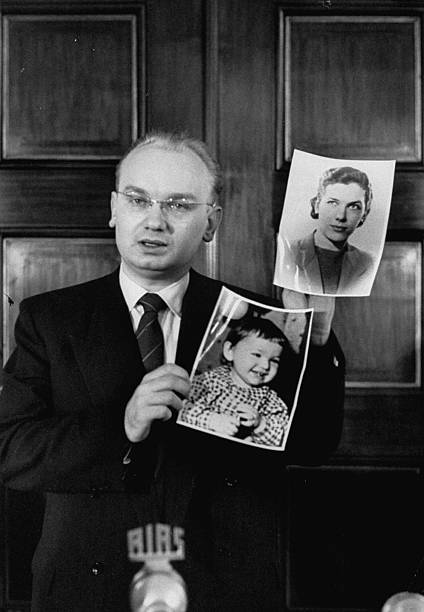
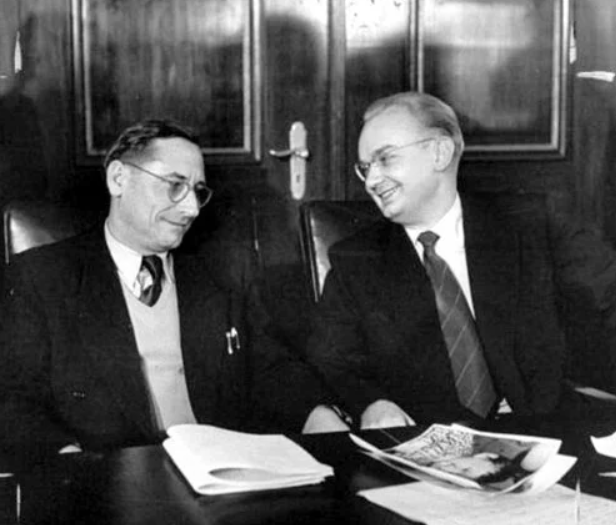
Khokhlov likely had a far more practical reason for defecting rather than a simple change of heart. His mission had been planned and initiated amidst the background of great changes at the highest levels of the Soviet government. Stalin had passed away in in the spring of 1953 and was succeeded by Lavrentiy Beria, the former chief of the NKVD, and one of the most cold-blooded men imaginable next to Stalin himself. Barely four months later, Beria himself was deposed by Nikita Khrushchev in a preplanned coup d’état. With Khrushchev working to de-Stalinize the USSR, Khokhlov’s position was far from certain once he returned home from this mission. Two of Khokhlov’s former chiefs at the MVD, Generals Leonid Eitengon and Pavel Sudoplatov had also been purged. It’s likely that he chose to risk everything in a bid to escape whatever fate awaited him back home, even if he successfully completed his assignment.
The Soviet Empire Strikes Back
For a time, everything went well for Khokhlov as he resettled in the United States. But the Soviets never forget a traitor. Over the coming decades they would prove this again and again, but Khokhlov would be the first of whom they made an example. In September 1957 while back in Frankfurt as a guest speaker at the annual Possev conference at the Botanical Gardens, Khokhlov suddenly took violently ill after drinking a cup of coffee. He was treated first at Frankfurt Hospital, and later by US Army doctors who believed he had been poisoned with thallium, an ingredient in rat poisons and ant killers at the time. However, they were initially baffled by his symptoms, including severe gastritis, which did not respond to conventional treatments for thallium poisoning. Khokhlov developed bizarre red stripes all over his skin, liquid oozed from his eyes, and clumps of hair fell off his head at the slightest disturbance.
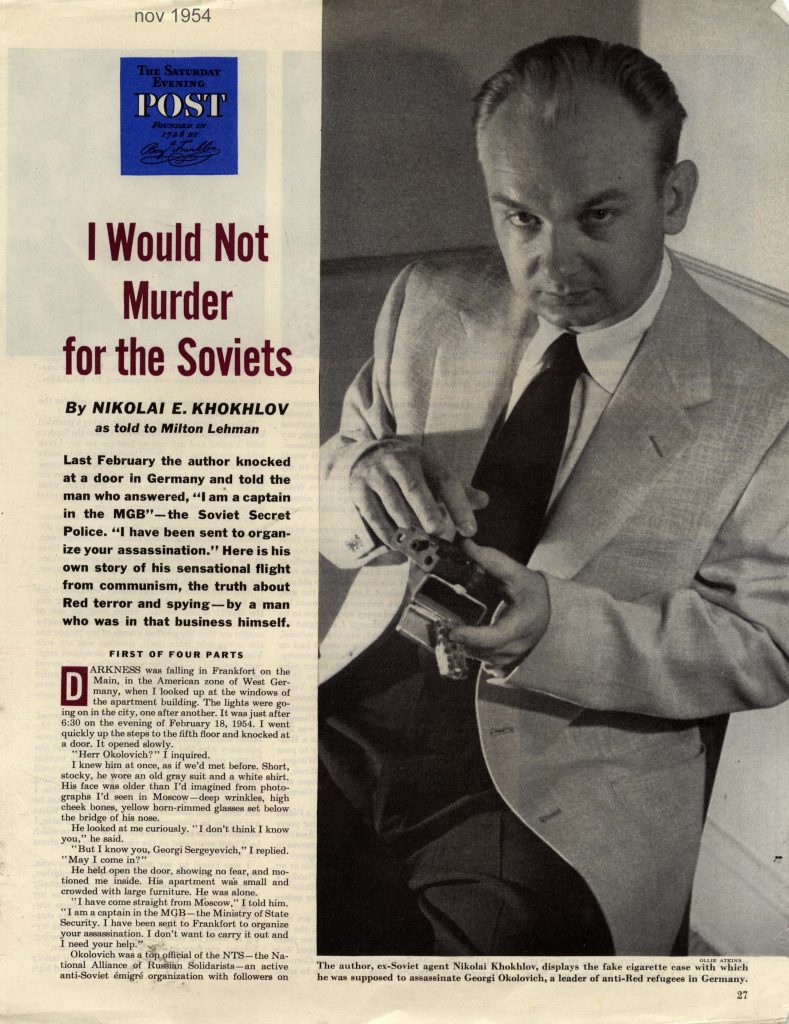
Eventually they realized Khokhlov was slowly dying of radiation sickness. After doctors changed his treatment to reflect the new information, which included repeated blood transfusions, he slowly recovered. Their final diagnosis was that the thallium he had ingested had also been irradiated before it was deployed. Years later, KGB defectors reported he had been poisoned with polonium-210, just as in the Alexander Litvinenko case which occurred in 2006. Litvinenko was also initially diagnosed as suffering from thallium poisoning.
The attempt on his life left him scarred, both physically and emotionally. As he wrote in his 1958 autobiography, “I, too, was an exhibit of the achievements of Soviet science. Totally bald, so disfigured by scars and spots that those who had known me did not at first recognize me, confined to a rigid diet, I was nevertheless also living proof that Soviet science, the science of killing, is not omnipotent.” Khokhlov also later reported that there was a second assassination attempt against him during the same period. While working on his autobiography in Paris in the spring of 1957, he befriended a group of Russian emigres there, including an elderly woman named Khristina Pavlovna. Unbeknownst to him, she was a Soviet agent, and began to gradually poison him, leaving him with severe gastritis for the duration of his time in Paris. But it had not yet proven fatal by the time he departed the city, and his symptoms disappeared upon leaving. Pavlovna would later be involved in the assassination of Soviet defector Victor Kravchenko, who was long believed to have committed suicide in February 1966.
After recovering fully and returning to the United States, Khokhlov studied at Duke University, majoring in psychology. While there, in yet another twist in his amazing life, Khokhlov became involved in the study of extra-sensory perception (ESP) and remote viewing. Working under the tutelage of Dr. J.B. Rhine at Duke’s Institute of Parapsychology, he authored a paper in 1966 titled, “The Relationship of Parapsychology to Communism,” in which he revealed previous Soviet experiments in the field to which he was knowledgeable before his defection. The Institute of Parapsychology at Duke University would later inspire early scenes in the 1984 film “Ghostbusters”, where Dr. Peter Venkman tests students’ ESP abilities.
Turning a New Leaf
Khokhlov went on to become a professor of psychology at California State University, San Bernardino from 1968 until his retirement in 1992. He continued his studies into parapsychology, offering workshops and authoring papers on the subject. Although not documented anywhere in open-source media, it is extremely likely that the CIA made use of their connection with Khokhlov during their own studies of remote viewing during the 1970s and 1980s.
In 1992, he was officially pardoned by Russian president Boris Yeltsin. Despite their best efforts, Khokhlov outlived the Soviet Union itself. He was eventually able to return to Russia and reunite with his wife Yanina, and even met a son he had never known existed, born after he departed for his fateful mission. Yanina and his children suffered greatly as a consequence of his defection and were never able to join him in the West. But when they were finally together again, nearly forty years after their last meeting, Yana told him, ““Why are you so worried about the past? Everything was done right. And, as you can see, everything turned out well.”
In 2006 Khokhlov gave an interview stating he’d traveled to South Vietnam in 1958 at the invitation of President Ngo Dinh Diem, to consult on how to counter aggression from North Vietnam. As a highly experienced partisan and communist agent, Khokhlov’s advice was considered of great value to the South Vietnamese President.
Khokhlov passed away in 2007 from a heart attack at age 85. One can’t help but wonder, with the advances in poison attacks since the two attempts on his life fifty years previously, whether the Chamber had anything to do with his final moments. Regardless of his cause of death, Nikolai Evgenievich Khokhlov passed away at the end of a long and incredible life at the forefront of the Cold War.
References:
Sudoplatov, Pavel. Special Tasks. 1994. Little, Brown, and Company.
Khokhlov, Nikolai. In the Name of Conscience. 1959. Van Rees Press.
Kovacevik, Filip. 2020. Russian Online Magazine: An Interview with Nikolay Khokhlov, KGB Defector Who Survived Poisoning Twice. The Chekist Monitor. https://thechekistmonitor.blogspot.com/2020/08/kgb-defector-khokhlov-interview-poison.html
Wright, Andy. 2017. The Russian Spy Who Convinced America to Take ESP Seriously. Atlas Obscura. https://www.atlasobscura.com/articles/nikolai-khokhlov-kgb-paranormal
Associated Press. 1954. Foreign News: The Whistler. Time Magazine. http://content.time.com/time/subscriber/article/0,33009,890887-1,00.html
Associated Press. 1954. Soviet Cigarette Cases and Toy Pistols Prove to Be Silent Arms for Assassin. The New York Times. http://content.time.com/time/subscriber/article/0,33009,890887-1,00.html
Synovitz, Ron. 2020. Name Your Poison: Exotic Toxins Fell Kremlin Foes. Radio Free Europe. https://www.rferl.org/a/russia-skripal-kremlin-foes-exotic-toxins/29083216.html
Handler, M.S. 1954. Another Russian Defects to West; Bars Slayer Role. The New York Times. https://www.nytimes.com/1954/04/23/archives/another-russian-defects-to-west-bars-slayer-role-secret-police.html?searchResultPosition=1
Raffensperger, Todd Avery. 2016. The Deadly Defector from the USSR. Warfare History Network. https://warfarehistorynetwork.com/2016/05/25/the-deadly-defector-from-the-ussr/
